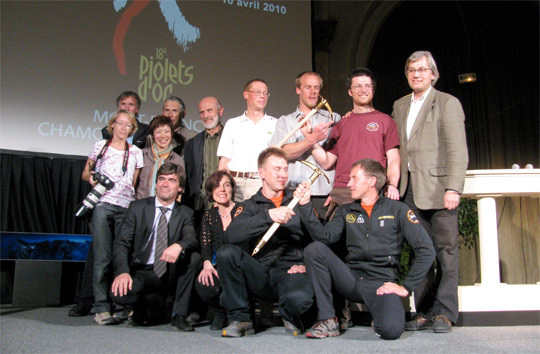
2010 Piolets d’Or judges, recipients and VIPs. From left, back row first: Lindsay Griffin, Jordi Corominas, Andrej Stremfelj, Bruce Normand, Kyle Dempster, Jed Brown, Robert Schauer; Anna Piunova, Kei Taniguchi, Eric Fournier (Mayor of Chamonix), Fabrizia Derriard (Mayor of Courmayeur), Boris Dedeshko, Denis Urubko. [Photo] David Falt
The 18th Piolets d’Or ceremonies were held April 7-10, 2010 in Chamonix, France and Courmayeur, Italy. Now in its second year since an abrupt termination in 2008, the revived event continues to struggle for its new identity.
After the 2008 hiatus, the Piolet d’Or returned in 2009 with a new charter designed to celebrate the spirit of alpinism rather than quantify it. Instead of awarding a single golden ice ax, last year’s jury presented axes to three out of six nominated teams, awarding each for excellence in what were perceived as different categories: technical, committing and exploratory.
This year, the jury shortlisted five teams, selecting ascents based on how well they aligned with the new charter.
Two teams were awarded trophies on April 10: Kazaks Denis Urubko and Boris Dedechko for their climb on the southeast face of Cho Oyu in Nepal, and Americans Jed Brown and Kyle Dempster, and Scotsman Bruce Normand for The Great White Jade Heist on the Xuelian massif in China.
Christian Trommsdorff, chairman of Piolets d’Or organizer Groupe de Haute Montagne, emphasized at the award ceremony that the winners exemplified the charter–an approach not taken last year–while the other nominees did not make the cut.
The Piolets d’Or website lists the charter criteria for valuating performances: style of ascent, spirit of exploration, level of commitment and self-sufficiency, required technical ability, suitability of route regarding objective dangers, efficient and sparing use of resources, transparency regarding use of these resources, and respect for locals, other climbers, the environment and future generations of mountaineers.
As the Piolet d’Or reemerges from its collapse in 2008, inconsistent judging criteria have caused some to question the permanence, role and rigidity of the new charter. Others wonder if the new incarnation articulates the spirit of alpinism any better than the original Piolet d’Or.
“The new Oscar style, as Christian Trommsdorff describes the event, will only stay relevant and avoid future controversy if the award criteria and process is clear and predictable,” one nominee said after the event. “I also think jury presentations should be open to the public.”
Reinhold Messner, who was awarded the 2010 Career Achievement Award, had a different perspective. He called the awards “a celebration of the alpine tradition. Alpinism starts where tourism stops. Today’s trade routes on the 8000-meter peaks–climbed by commercial expeditions using fixed ropes, camps and Sherpas–are pure tourism that has nothing to do with alpinism. The Piolet d’Or celebrates alpinism.”
Messner also pointed out that today’s Basque and Japanese expeditions working on Annapurna are much heavier in style and tactics compared to the expedition led by Maurice Herzog in 1950. Hertzog, also present in Chamonix for the event, participated in a panel discussion with Messner and agreed that many modern expeditions take a less-than-modern approach to alpinism.
Both Hertzog and Messner, however, were impressed with and praised the light style chosen by all five nominated teams.

Walter Bonatti, left, with Reinhold Messner, who won the 2010 Career Achievement Award. [Photo] Pascal Tournaire